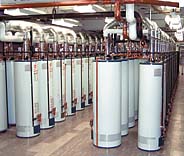Effective July 1, 2003, residential gas-fired water heaters with storage capacities of 30, 40, or 50 gallons must meet a new American National Standards Institute (ANSI) standard, ANSI Z21.10.1-2001. In a nutshell, any conventional, atmospheric-type water heater with a storage capacity of 50 gallons or less that is produced on or after the effective date must be designed so it cannot ignite flammable vapors caused by spilled gasoline outside the unit. The new ANSI FVIR standard will not affect the current installed base of residential gas-fired water heaters, nor any unsold water heaters manufactured prior to July 1, 2003, regardless of size or Btuh input. The standard applies to both natural gas and liquid propane units.
Eventually all residential, gas-fired water heaters must meet the new ANSI standard in three phases over the next three years, as shown in Table 1.

Why A New Standard?
The new ANSI standard is the result of a voluntary, joint effort involving every major producer in the water heater industry. Current water heater designs have proven themselves safe and reliable when installed, used, and maintained properly. Unfortunately, occasional accidents have been caused by the improper use and storage of flammable, vapor-producing liquids near gas-fired equipment, such as water heaters and other common household appliances.The water heater manufacturers came together, in cooperation with the Consumer Products Safety Commission, to form the Joint Research and Development Consortium. The goal of this alliance was to develop technologies for gas-fired water heaters that would resist igniting flammable vapors that result from the mishandling of gasoline and other flammable products.
This venture required manufacturers to share research and patents, while concurrently investing their own resources in new FVIR product designs and the methods to test them. The resulting efforts have capitalized on the industry’s extensive product and applications expertise. The new ANSI standard is a milestone because it represents an industry-driven approach that will ensure the long-term reliability of the new FVIR technologies.

What Is An FVIR Water Heater?
The water heater consortium carefully considered a number of possible solutions to the FVIR problem, but quickly formed a consensus around three principle technologies:These technologies will be included in every new FVIR water heater, regardless of manufacturer. The water heaters will generally work such that combustion air, as well as flammable vapors, flow through the flame arrestor plate into the combustion chamber where they are ignited. The arrestor’s job is to create a one-way path. Once inside the water heater, combustion air and flammable vapors cannot reverse direction. That is, they cannot migrate back through the plate, outside the water heater and into the room. Consequently, in the event of a flammable vapor event, the flames would be contained within the water heater, protecting the surrounding area.
The Importance Of LDO
Early in the development of the new FVIR technologies, researchers for one of the members of the consortium discovered that arrestor plate designs were vulnerable to the effects of contaminants in the air, such as lint, dust, and oil (LDO).Researchers found that these contaminants could clog the arrestor over time, interrupting the smooth flow of makeup air into the combustion chamber and undermining performance. Under these conditions, the burner would be starved for oxygen and might release unacceptable levels of carbon monoxide into the atmosphere.
In response to these concerns, the consortium enlisted an independent testing laboratory to investigate the issue. When experiments confirmed that LDO is a genuine threat to water heater performance, the new ANSI standard was amended to include testing for reliability in LDO environments.
Some Things Won’t Change…
How exactly will these changes impact the contractor? At a glance, the new FVIR water heaters will appear much the same as the models they will replace. Installation practices won’t alter much either, although one change should be warmly welcomed as clear-cut improvement.Unlike their predecessors, the new FVIR water heaters do not offer easy access inside through a small, removable door attached to the bottom of the tank jacket. But installers will no longer need this access to light the burner. Instead, the new units will use some type of matchless, manual spark ignition.
…But Other Things Will
Despite all this continuity, the different makes of water heaters will not be interchangeable. Consortium members shared information and patents with one another to create the new FVIR technology. But each manufacturer ultimately pursued its own design. As already noted, flame-arrestor technology will be common to every new water heater, but there will be important differences in how the designs respond to flammable-vapor incidents and LDO. For example:Whatever brand they install today, contractors should take the time to investigate the design and performance differences among the various makes and models. Only by fully understanding all these differences can they decide which brand will provide the best long-term solution for their builder and consumer customers.
Martin is with the Water Heater Division of Rheem Manufacturing Company. Based at Rheem Water Heaters headquarters in Montgomery, Ala., he can be reached at 334-260-1500.
Publication date: 07/21/2003

Report Abusive Comment